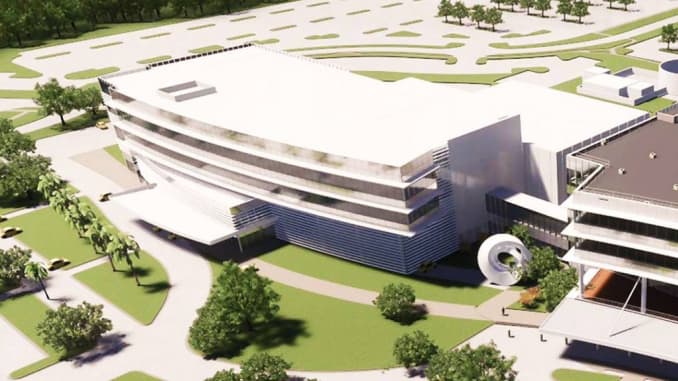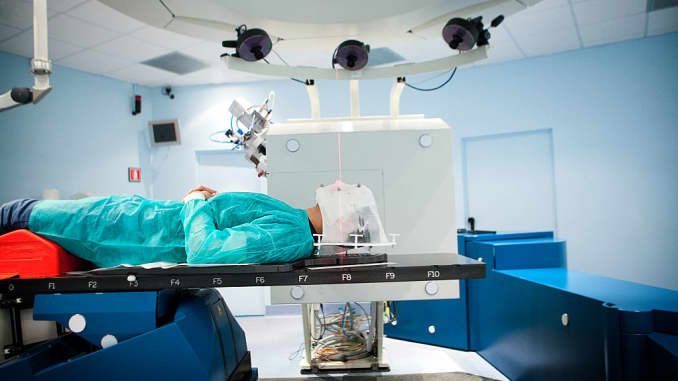
America’s war on cancer is about to get another tool in its arsenal. The country’s first carbon ion therapy center to treat cancer is being built in collaboration with Hitachi on the campus of the Mayo Clinic in Jacksonville, Florida. The cancer therapy treatment will be part of Mayo’s $233 million oncology facility, announced in June.
An alternative to surgery, this new treatment is viewed as the next horizon of cancer care. It has the capability of killing cancer cells that are resistant to traditional radiation therapy. Yet the U.S. has been slow to adopt the treatment even though the technology was developed in California in 1975.
According to experts, carbon ion therapy damages the DNA of fast-growing cancer cells, ultimately destroying them. But unlike older forms of radiation, this technique causes minimal harm to normal tissue. Studies also suggest it triggers an immune response against cancer.
Dr. Steven Buskirk, chair of the department of radiation oncology at Mayo Clinic in Florida, says, “the availability of carbon ion technology will allow Mayo Clinic researchers to evaluate the efficacy of carbon ion therapy for the treatment of various cancer types, including exploration into new and expanded therapies, including multi-modality treatment options.”
“Some cancers are inherently resistant to conventional radiation, and we wish to initially evaluate the efficacy of carbon ion therapy in these cancers,” he explains.
The plan is to put together a national Scientific Advisory Board composed of doctors and scientists from the U.S. and abroad to study the efficacy and safety of the treatment and secure FDA approval so the treatment can be offered in 2025, says Dr. Kent Thielen, CEO of the Mayo Clinic in Jacksonville. He notes that his institution is a leading National Cancer Institute-designated comprehensive cancer center, and Mayo Clinic radiation oncologists and physicists have been studying carbon ion treatment in Asia and Europe for nearly a decade. Mayo already has developed a high level of expertise in treatment planning and delivery.
Mayo Clinic’s Jacksonville oncology center will also include proton beam therapy for cancer patients so it can offer the full spectrum of treatment options.

Other countries have been quick to adopt carbon ion therapy over the last 25 years. Japan built the world’s first ion carbon therapy center in 1994 after the Lawrence Berkeley National Lab, the U.S. lab that developed it, shut down in 1993. Today there are such centers in Germany, Austria, Italy, Japan and China. More locations are under development in South Korea, Taiwan and France.
A new frontier in medical science
America has lagged because it has been difficult to obtain federal funds or sufficient private backing to develop such facilities. “The lack of scientific research and scientific efficacy has also been a factor,” says Dr. Jeffrey Buchsbaum, program director of the radiation research program at the National Cancer Institute.
What has flourished instead is a related approach called proton therapy, which also uses charged particles and has some of the same benefits. Today 31 U.S. proton centers offer treatment for cancers in areas where radiation damage to surrounding normal tissue could be dangerous or even deadly, such as tumors at the base of the skull or tumors in young children.

Carbon ion therapy is similarly precise, but because carbon ions are heavier and 12 times the size, they deliver more cancer-killing power than protons do, many experts say. Carbon centers have reported impressive survival rates, particularly for hard-to-treat bone and soft-tissue cancers such as spinal tumors.
The therapy involves accelerating carbon ions to near the speed of light, then “painting” a tumor with the radiation beam. Accelerated particles deliver their energy in a sort of delayed burst called a Bragg peak, so that very little damage occurs to normal tissue as the beam enters the body in a thin stream at a high velocity, and the killing power is concentrated on the tumor, where the particle track stops. (Traditional radiation damages tissue as the beam enters and exits the body, although radiologists use techniques to minimize the damage.)
The next step is to do the clinical studies to see where carbon ion therapy is appropriate to use. Toward that goal the National Cancer Institute is funding grants to uncover the properties of the ionized particle. This is key, since the particle beams produce different biological changes at different doses.
“Our focus is to develop the best and safe treatment based on science,” says Dr. Buchsbaum. “Carbon ion is a complex therapy that needs further study. There remain a lot of unknowns.” As he explains, it is just one of a number of particle therapies under investigation for the treatment of cancer. Others include protrons, helium and antiprotons.
Clearly, the interest in the field is gearing up in the U.S. The Albert Einstein College of Medicine in New York has collaborated with the Shanghai Proton and Heavy Ion Center in China to conduct a Phase 1 trial of carbon ion therapy to treat pancreatic cancer.
[“source=cnbc”]
